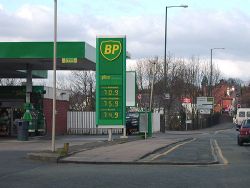Petrol station
| Petrol station | |
 | |
| A typical example of a petrol station | |
| Pictures related to Petrol station View gallery (210) | |
Petrol Stations, also known as Filling Stations, Garages, Local Services, or (in the US predominantly as Gas stations) are the smaller relative of moden Motorway Service Areas and have become an increasingly prevalent roadside feature since the dawning of the era of the motor car, replacing the Inns of the staging coach era as the place where fresh supplies are taken on for the journey ahead.
Many petrol pumps started out life as tanks and pumps linked to an existing shop. Later, dedicated buildings were constructed, and in the UK large canopies were constructed to keep the elements from motorists refuelling. Many petrol stations also feature a large illuminated display, detailing prices of different grades of fuel.
In the UK, from the 1960s onwards, self service became normal, with motorists filling their own cars with fuel and then paying afterwards in the kiosk. Some examples of attended service still exist within the UK, but these tend to be smaller petrol stations off the beaten track which have never seen the need to move to self service, or where drive-offs are a particular issue and the petrol station does not have the resources to use ANPR or pre-payment. In the UK, the most common form of petrol station use is self service with the customer paying after having fuelled their vehicle. In other countries, particularly on motorways and at night, advance payment is often required.
Typically, in a modern petrol station, the attached kiosk acts as a convenience store, selling sandwiches, coffee, and household essentials as well as spare bulbs and other items traditionally associated with the automotive age. Some are full-blown supermarkets (Esso have a deal with Tesco Express for instance), which have developed as a way to ensure that a community doesn't lose its village store or filling station. In some cases, most obviously the A9 between Perth and Inverness, local petrol stations completely replace roadside service areas, and are signed as "local services" along the main road. Whilst it is down to the discretion of the local authority, Off licence sales are somewhat less common in filling station shops than normal convenience stores, to try and reduce the effects of drink driving.
Throughout the 1980s and 1990s in the UK, supermarkets increasingly added filling station forecourts to their out of town superstores. This, coupled with bypasses with modern, larger trunk road service areas has meant that many early examples of petrol stations have fallen out of use and been redeveloped.
Fully automatic self service petrol stations appeared in earnest in the 2000s, driven by supermarkets keen to cut costs to provide automatic unattended fuelling at night and reduce staff needed to run the filling station kiosk during the day. 'Pay at Pump' is now a common feature at Tesco, Morrisons and Asda stores, with the latter having a number of completely unattended filling stations, with just a phone to contact the main store if assistance is required. Prior to Pay at Pump, Asda had a number of filling stations, some of which survive, where there was no kiosk as such. After filling the tank, customers drove forward to a small kiosk, similar to a toll booth, and were served through the windows some even had automatic barriers to ensure that customers paid before leaving. At some sites, especially in very remote, rural areas filling stations are unattended at all times, requiring the user to pay by cash or card in advance of fuelling. Examples include Durness and Applecross in the Scottish Highlands.
This BBC News Article contains photographs of the following petrol stations:
- Red Hill Service Station, Leicester on the A6 - with unique canopies; architect Eliot Noyes designed thousands of filling stations for Mobil worldwide, and this one is now Grade II listed
- Attended service on the Euston Road, London, 1922
- Bonds Garage, in Barkway, Hertfordshire - an example of a 1930s purpose built petrol station and matching house, now demolished and replaced with houses.
Other interesting filling station buildings include:
- Southside Garage, Causewayside, Edinburgh, 1933: art deco filling station whose architect was Sir Basil Spence, also designer of Coventry Cathedral; now a Majestic Wine Warehouse
- Markham Moor, West Drayton, Nottinghamshire, on the A1, built in the 1960s with a curved concrete roof by architect Sam Scorer and structural engineer Hajnal-Kónyi, later converted into a Little Chef and Grade II listed
Other than petrol and diesel fuel, various filling stations have over the years offered other fuels, including Liquid Petroleum Gas, Agricultural Diesel, and more recently electrical charging points.
Links
- The Amazing Architectural Evolution of the Filling Station, Gizmodo
- BBC News: Fuelling communities - The stories behind the UK's independent filling stations (December 2018)







